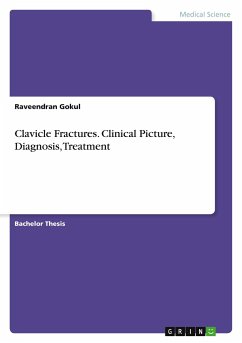Bachelor Thesis from the year 2024 in the subject Medicine - Surgery, Accident Medicine, , course: MBBS, language: English, abstract: The aim of the thesis is to investigate theoretical data (classification, epidemiology, symptoms, treatment, complications) in order to improve the knowledge and management of clavicle fracture and to analyze the clinical data of the patients with CFs treated in the Department of traumatology nr.1, Institute of Emergency Medicine, during the years 2019-2023. Clavicle fractures usually affect people under the age of 25, with children and young adults suffering from them the most frequently. The clavicle is a common area for injury due to its superficial placement, its thin midshaft, and the pressures transmitted across it. A hard fall with the arm at the side, which frequently happens during contact sports, is the most frequent mechanism of injury. The history and physical examination can frequently make a diagnosis, but suitable radiography should be done to confirm the diagnosis and provide treatment options. The majority of midshaft clavicle fractures can be managed nonoperatively. Children frequently have significant calluses, so parents may need assurance. Surgery is an option for fractures with a high risk of nonunion (e.g., displaced or comminuted fractures, fractures with more than 15 to 20 mm clavicle shortening). The relationship of the distal fracture to the coracoclavicular ligaments determines the likelihood of displacement.
Hinweis: Dieser Artikel kann nur an eine deutsche Lieferadresse ausgeliefert werden.
Hinweis: Dieser Artikel kann nur an eine deutsche Lieferadresse ausgeliefert werden.








